The first Monument of the year, this Saturday’s Milan-Sanremo is all about the tense finish, the paradox of the longest race of the year that’s often decided in the final metres and one of the rare one day races where grand tour contenders and sprinters can each stake their claim. Who will keep their nerve?
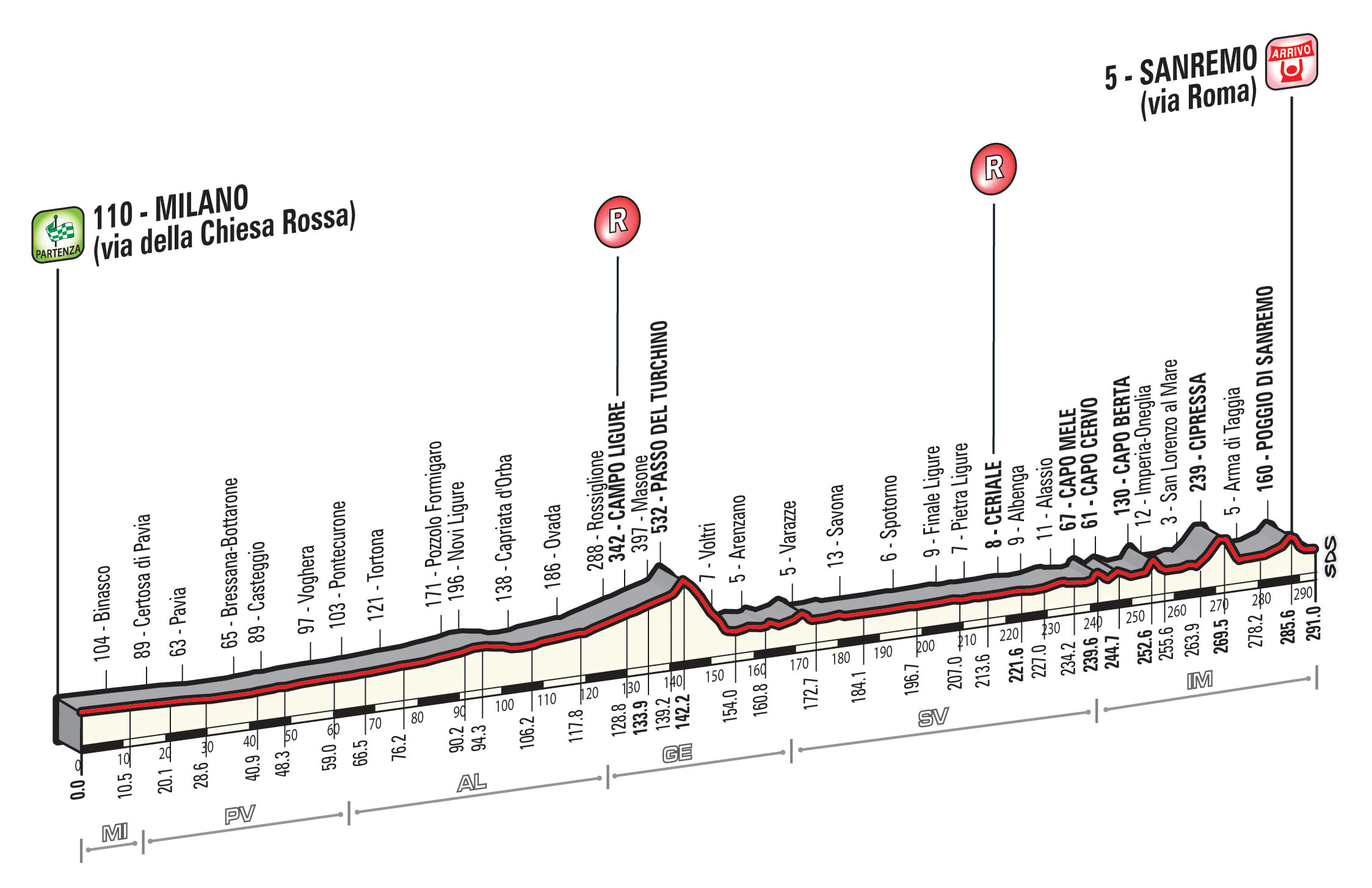
The Route: exit Milan and the race speeds across the vast Po valley and the Pianura Padana, the plains that grow much of Italy’s rice crop. Ovada is the town marks the start of the long Passo del Turchino. This mountain pass used to be important to the race but it’s a slow and gradual climb, the road is tracked by a railway line, a clue to the gentle gradient. Turchino means a shade of blue in Italian, hinting at the Mediterranean sea that awaits on the other side. The pass is a symbolic moment, lifting riders away from the foggy plains towards the shimmering spectacle of the Mediterranean, winter to spring via one mountain pass. The narrow tunnel at the top has now been widened into a regular one.
The race drops down to the coast via a steep descent with tunnels to the outskirts of Genova and the stress ratchets up. The halfway point is crossed but the finish feels closer, the coastal road familiar. The race goes from one town to another, negotiating modern street furniture and antiquated town squares alike. In time comes the cape trinity: Capo Mele, Capo Cervo and Capo Berta. These are small climbs but serve as landmarks to break up the flat road and by now the race has done 250km.
Then it’s on to the Cipressa. This starts with sharp right hander and quickly climbs through olive groves above the coastal town of San Lorenzo, the nine percent gradient bites hard after 270km. This is a proper moment of climbing that can prove fatal for the sprinters, the average of 4% is a blend of a steep start and a flat portion over the top where dropped riders flounder. Television cameras often follow the back of the peloton to catalogue the dropped riders because the toboggan-run descent, the most technical part of the entire course, is often too fast to film in full.
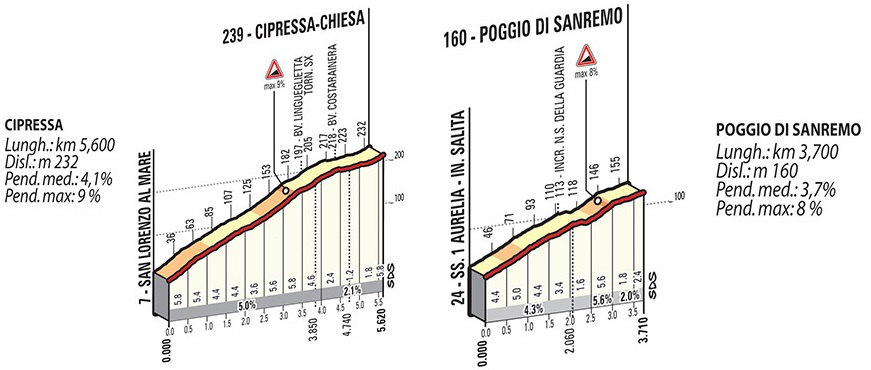
The Finish: the Poggio starts with 9.2km to go and marks the final phase of the race. A furious pace is inevitable. A right flick off the main coastal road is followed by series of wide bends that are so fast some riders have to brake before entry despite going uphill. Positioning is everything as the road winds up, every metre matters. Unlike the Cipressa this isn’t steep, there’s only one short step at 8%. But after 285km the elastic is like an old rubber band and the Poggio is just enough snap the peloton.
The descent is fast and marked by a series of curves and five hairpins. The race has been won on the descent before and it has its technical moments, for example knowing which bend has the sunken inspection cover on the exit line helps but this is not for virtuoso descenders, instead it suits those with power, a series of sprints out of every corner. Carrying speed into the bends matters but what matters more is being able to pump out big watts on every exit. The ramp ends with fast junction onto the main road and it’s left at the fountain, then right on the Via Roma, the “old” finish, sloped with the slightest of slopes up to the finish line.
Using the Via Roma again, and not the Lungomare, matters as it means the finish is closer to the bottom of the Poggio, there’s less time for dropped riders to come back on the descent and in town.
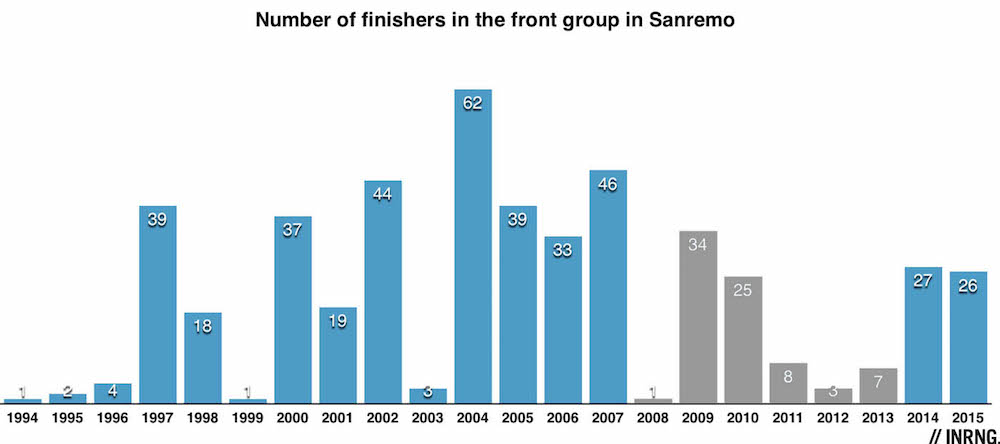
The Scenario: a bunch sprint? If only it was so simple. The chart above shows the size of the front group in Sanremo over the years. All the blue bars represent the Cipressa-Poggio combo while the grey ones represent the harder years with the additional climb of Le Mànie, now skipped. It shows any “bunch” sprint is really a reduced group, on average the Poggio reduces the race to 20-40 riders. With seven hours in the legs the resulting sprint is a test of force and energy rather than pure speed and few have a team mate left to lead them out.
We’ll see an early move go clear. Look to see which teams place riders in it and if there are any big engines in the move to keep it clear for as long as possible. As ever the pace ratchets up along the coastal road, on TV you might see a bunch of riders, the trick is to spot which teams still have plenty of riders.
Onto the Cipressa and long range moves are hard but the harder the pace, the more the sprinters will struggle. It’s got some steep sections and it’s easy to crack and then lose 30 seconds over the flat section to the village of Cipressa: game over. There’s always a danger moment on the flat coastal section to the Poggio as a move can slip away while others get into position. The Poggio’s early slopes can look slow on TV but chances are the bunch is going full gas only space is at a premium and the riders are packed like sardines. The best attacks came late on the steepest part after the chapel on the left and a breakaway only needs 10 seconds over the top to stay away. With the return to the Via Roma there’s less time to pull back a move but the wide, straight road also encourages the surviving bunch to chase any fugitives all the way to the line.
The Contenders
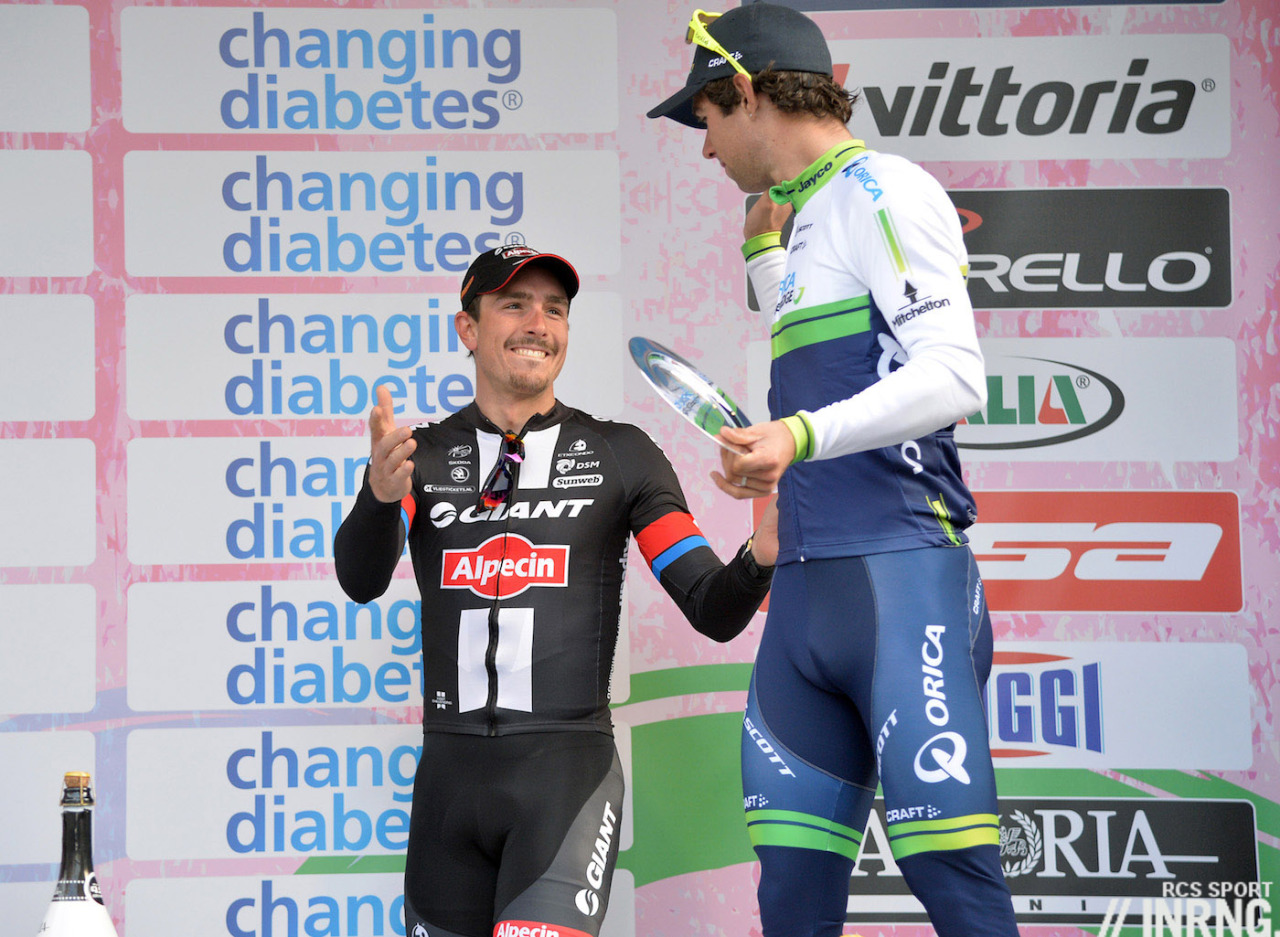
Michael Matthews can do it all, the hills pose no problem and he’s got a fast finish. Third last year and now he seems to be going even better with two stage wins in Paris-Nice. He’s got the Midas touch, the ability to win big when it matters and he’s been targeting this race for two years now and lives just up the road in Monaco. Simon Yates, Michael Albasini and Daryl Impey are on hand to help make it happen.
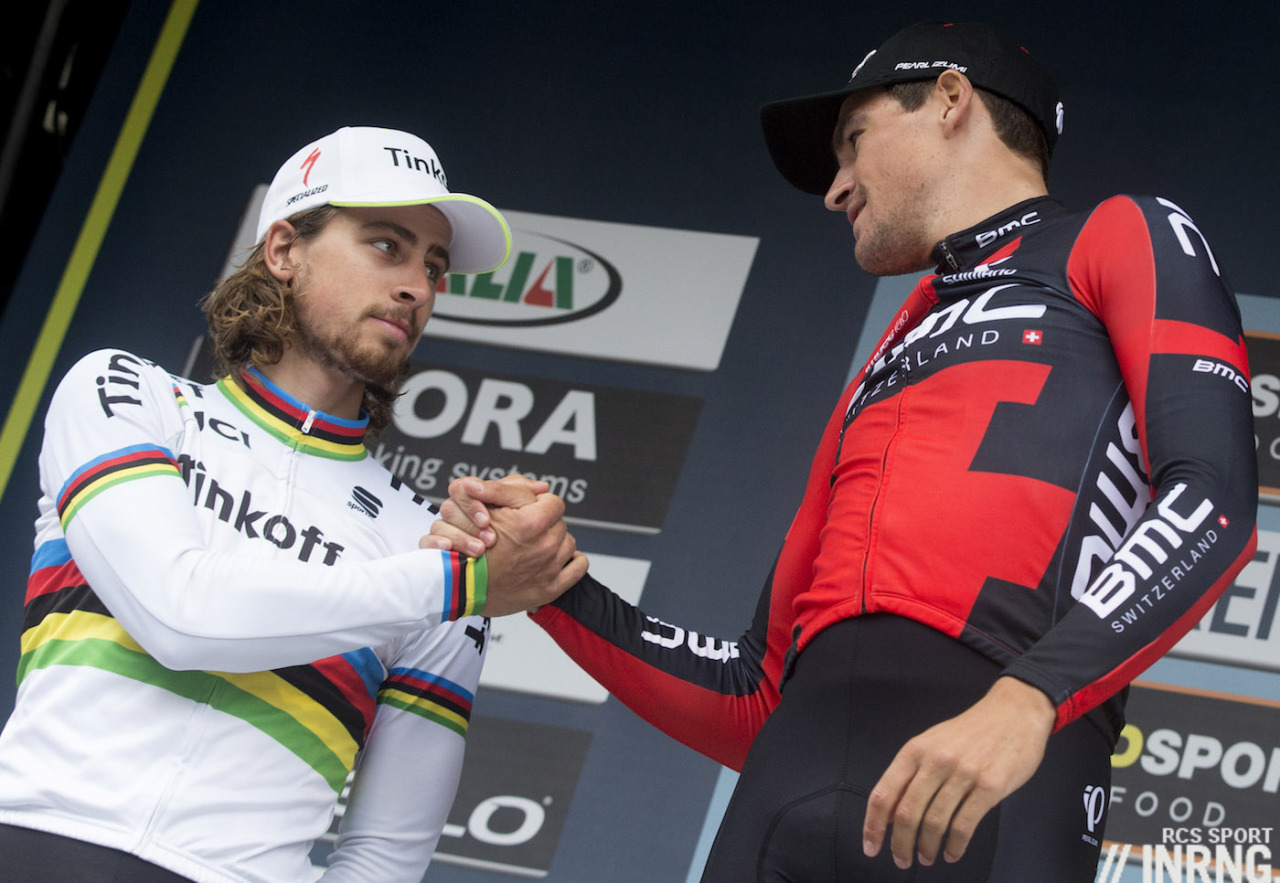
Peter Sagan is becoming more famous for losing than winning, partly because his losses are so visible. Just as light shone through a prism splits into a rainbow, Sagan’s rainbow jersey does the reverse, the rainbow bands generate a beam of limelight that illuminates his every mistake. The goal this year is a Monument classic and nothing else matters. He’s been beaten in straight sprints and does look like someone you’d want to play poker with as he signals his moves too much. Will he attack on the Poggio or sit in for the sprint? He can do both and this gives him a strong chance of being on the podium. If anything the Poggio descent is his best bet, he can put his skills to use in the corners and his power on their exit.
Greg Van Avermaet is the form pick. As well as strong legs he’s been looking mentally sharp and seems to have a new self-confidence to back himself in the sprint. But how does he win? He and others will need to slip away over the Poggio and if he goes then chances are the likes of Sagan, Cancellara are there which is exactly what happened last year only for the move to be closed down. Even if the move sticks, a big ask, he’s then got to win the sprint. It can be done but the chances are not as likely as his red hot form needs.
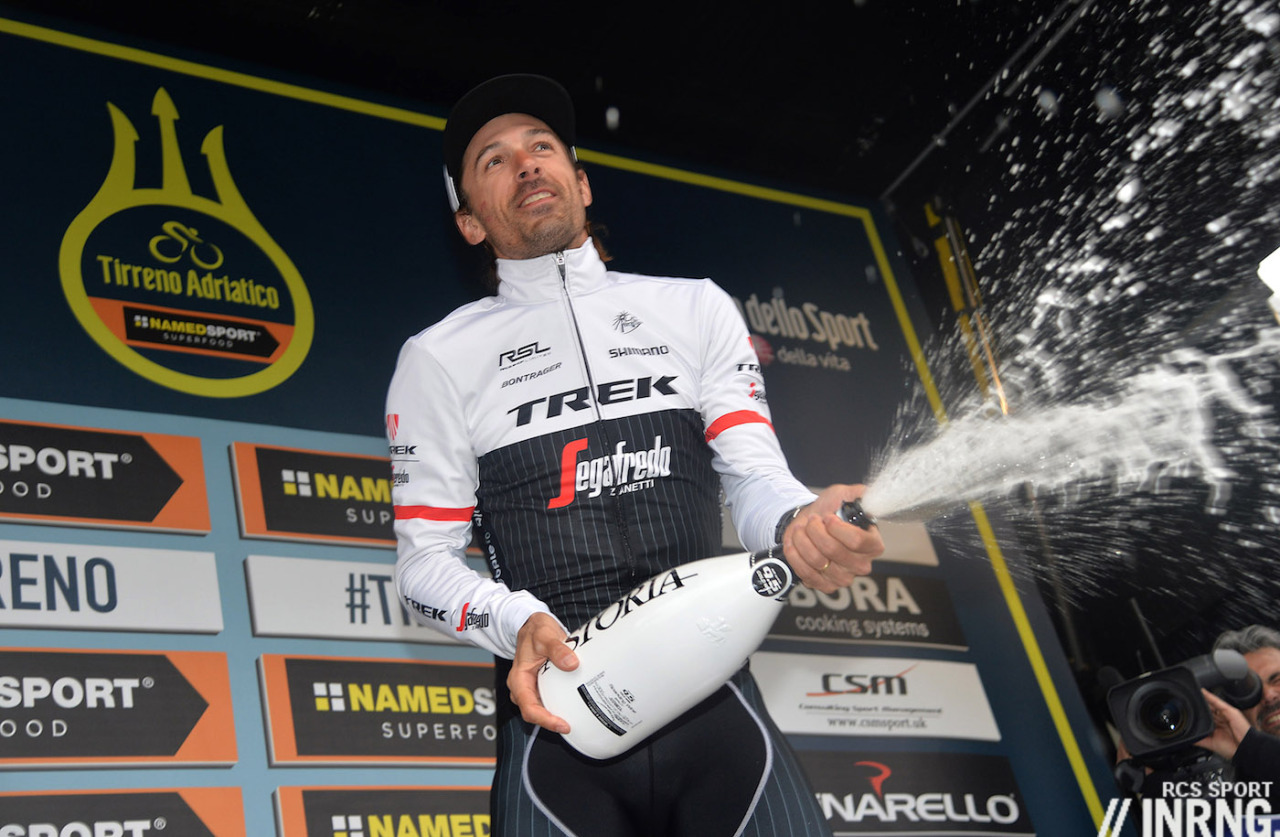
Fabian Cancellara is in top shape and has stood on the podium in this race five times including one win. He’s looking lean and an attack over the top of the Poggio looks predictable but who will have the strength to follow especially as he can power down the descent too? He can finish fast after a hard race but it’s difficult to see him bettering the more specialist sprinters, he was seventh last year in the sprint. Trek-Segafredo team mate Niccolò Bonifazio is a back-up plan, fifth last year and sprinting well this season but yet to win a World Tour race.

Alexander Kristoff has been first and second in the last two years which alone is enough to earn him a big tip. He enjoyed an excellent start to the season but had a quiet Paris-Nice by his standards, if only he’d looked more convincing in France he’d get five chainrings. He’ll also miss Luca Paolini who for all his faults has been determinant on the Poggio in the last two years and an important consigliere. Still by now he knows what to do and has the power to deliver another win.
Team Sky really want to a win a Monument classic this year and looking at their entrants for this race you could argue all of their eight riders have a chance, even gregario Salvatore Puccio has looked strong of late. Geraint Thomas is obviously in great shape right now and could surge on the Poggio. Ben Swift has been going well in Paris-Nice, almost a comeback after a quieter 2015. He’s prototype sprinter for this race as someone who is fast in the finish but also lighter for the climbs. A win would be an upset but a podium is possible,he was third in 2014. Michał Kwiatkowski has outsider status because he’s had a quiet start to the season but has the power and skills to join any move over the Poggio and can win sprints too, witness his Amstel triumph last year. Flower power in Sanremo, the city of flowers?
Another prototype rider is Edvald Boasson Hagen. The Norwegian has disappointed in this race time after time because he seems perfect for the Poggio and the sprint. Only his best result in Sanremo has been 10th place. This season things are going better for him and he showed excellent form in the Tour of Qatar. But 300km? Distance has always been a problem for him. Dimension Data team mate Mark Cavendish rides but was out of the mix in Tirreno-Adriatico and given his focus on the track, converting to the road all of a sudden is a big ask. It took months of work to deliver his 2009 Sanremo win and this build-up hasn’t happened this year. Still if he can hang on then the Via Roma’s slight headwind suits him.
Fernando Gaviria has been the subject of much interest but a 300km race sounds like a big ask for someone fresh out of the World track championships. But this is Fernando Gaviria who has just won a stage of Tirreno-Adriatico with, visually at least, one of the most powerful displays we’ve seen this year. Still, I think he’s a distraction, a ruse to take the heat of Etixx-Quickstep’s Czech ace Zdeněk Štybar. His problem is he’s too obvious right now, he’s bound to try a move over the top of the Poggio or perhaps at the top and use his skills and power to get away on the descent but if he does then what chance he gets followed and beaten in the sprint? Tom Boonen rides too and could surprise in the sprint but he’s never fared well in this race, at least by his high standards. But what if Matteo Trentin was their best bet, the big chinned sprinter from the Dolomites can cope with a climb or two, this was how he won Paris-Tours last year.
Movistar have the twin options of Alejandro Valverde and Juan-José Lobato. Valverde surely needs a hillier course, it’s hard to see him sprinting for the win. Lobato was a contender last year after beating John Degenkolb in several sprints but he’s gone quiet of late and looks less of a threat which might suit him fine so that he can play the Oscar Freire role and pop up for the win that nobody expects.
Lampre have Rui Costa and Diego Ulissi but both would like a harder course, perhaps they’re in the action but not the results? Sacha Modolo first made a name for himself in this race but hasn’t looked too sharp yet this season.
Jens Debusschere leads the sprint options for Lotto-Soudal but Tony Gallopin is the more versatile option and he’s coming into form after Paris-Nice while Tim Wellens is out, ill.
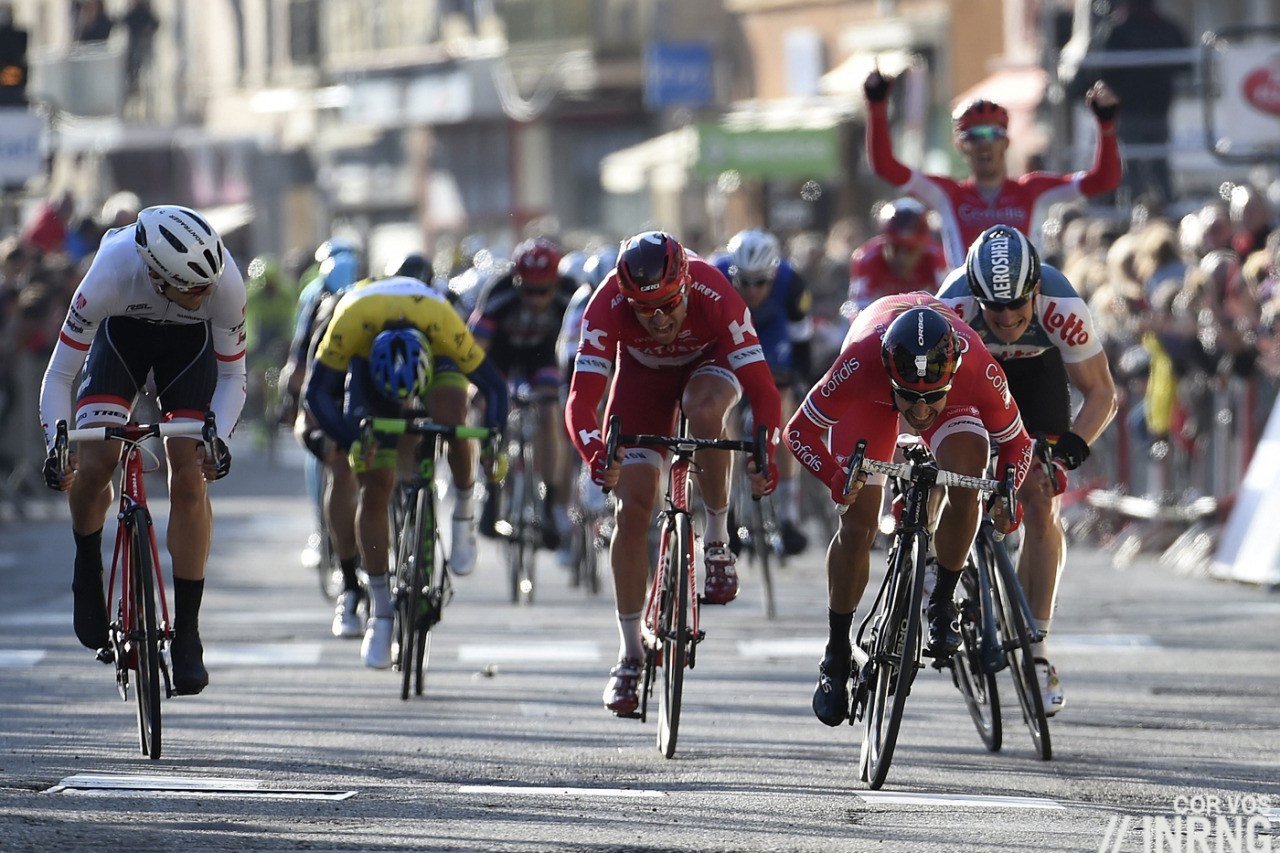
Nacer Bouhanni has had two goals for the first part of the season: a stage in Paris-Nice and winning here. So far he’s met the first goal but a triumph in Sanremo seems a much bigger ask, a trophy beyond his stature. Yet the signs are all there, he was beating Matthews and Kristoff in the sprints in Paris-Nice and he can get over the hills, his best wins have come this way and he’s done well in the Worlds before, long distances suit him. Sixth last year after mangling the approach to the sprint he can go better than many expect. As ever it’s win or bust.
Arnaud Démare of FDJ was sprinting very well in Paris-Nice and he can cope with a climb or two and sprints better after a hard race but he quit Paris-Nice with a sore knee and 300km is not ideal. If he can cope with the climbs the long, slightly uphill sprint of the Via Roma is ideal for him.

Vincenzo Nibali rides. After ruffling RCS’s features last weekend he’s back on good terms and has decided to add this race to his plans. He is in form and has lit up this race before, it was his attack in 2011 that was tracked by eventual winner Simon Gerrans and he was on the attack over the Cipressa in 2014. His problem is that the course is not hard enough, indeed the attempt to introduce the extra climb to Pompeiana has been partly about ensuring a domestic triumph for the Italian champion. So he could well feature but a win looks improbable. Alexey Lutsenko is a dark horse for a longer range bid.
Ag2r La Mondiale’s Jan Bakelants is having a good start to the year and in the thick of many moves, you expect him to be in the mix on the Cipressa but a win seems unlikely. Sonny Colbrelli is Bardiani-CSF’s best hope, he’s a budget Italian version of Peter Sagan who is good on punchy, hilly courses and has won already this year. Cannondale’s Ramūnas Navardauskas packs a good sprint after a long race, he got a bronze in the worlds last year and Simon Clarke is in good form for the team. Bora-Argon 18’s Sam Bennett could win this race one year if he keeps improving but so far he’s having discreet start to the season and was being dropped in Tirreno-Adriatico before he could contest the sprints. Sep Vanmarcke‘s form is rising nicely ahead of the cobbled classics but since he surely can’t win a bunch sprint he’ll need to take a flyer on the Poggio and if he gets away, there’s a good chance he’s got company who can beat him in town.
| Michael Matthews | |
| Fabian Cancellara, Alexander Kristoff, Greg Van Avermaet, Peter Sagan | |
| Nacer Bouhanni, Zdeněk Štybar, Geraint Thomas, Edvald Boasson Hagen | |
| Michał Kwiatkowski, Tony Gallopin, Arnaud Démare | |
| Trentin, Vanmarcke, Swift, Navardauskas, Cavendish, Gaviria, Bonifazio |
Weather: dry with sunshine and some clouds along the way. The coast won’t any warmer than inland with cool temperatures of 13°C. There will be a gentle Westerly wind meaning a headwind along the coast.
TV: the race starts at 10.10am Euro time. Italian TV starts coverage at 2.30 pm CET with most international coverage too. For English-speaking readers it’s on Eurosport for the UK and Ireland and SBS in Australia. Sadly BeIn own the rights in the US but won’t be showing it.
The finish is expected for 5.10pm Euro time but with a large margin given the distance involved. Part of the experience is watching the race build so tune in early if you can. The Capo Mele is scheduled for 3.50pm and the Cipressa for 4.25pm. The final hour is crucial with the capes and the hills. As ever steephill.tv and cyclingfans.com are the go-to sites for TV schedules and feeds.
Sanremo or San Remo? Both. Ride into town and you’ll see signs saying “Sanremo”, arrive by train and the station says “San Remo”.

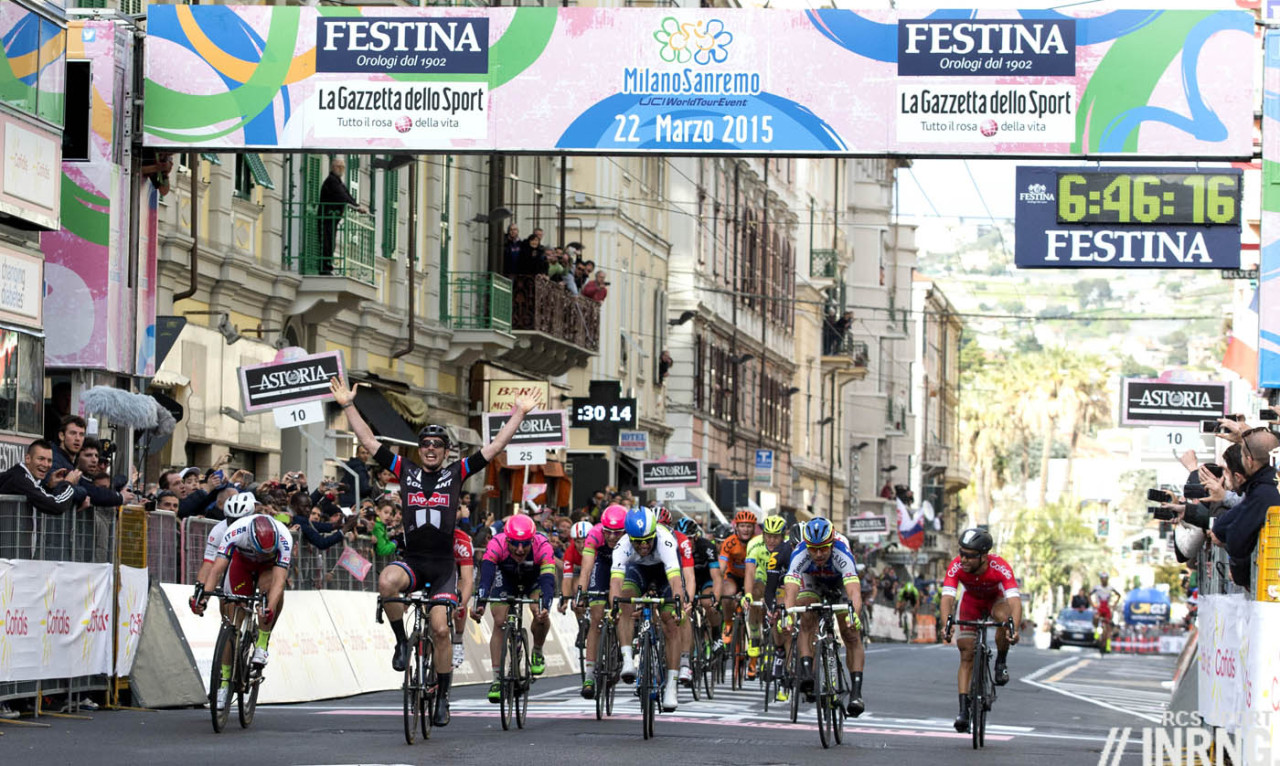
Another excellent piece. Thanks.
ps Sanremo over the tears…
For many it has ended in tears over the years 🙂
As glorious as it would be, a Sagan move near the top of the Poggio may as well be signposted for all to see; still I agree with Inner Ring that it could be his best best – if I were him I’d perhaps slip a rain jacket on before he reaches the final climb, as that white rainbow jersey only needs a blue flashing light accompaniment on his helmet to be more conspicuous!
Slightly left field choice for me; Nacer Bouhanni – stay on the right wheels, don’t do a thing until the last 200m.
I think he looks like he might do it too, faster sprinters are out of contention and he’s had some good wins this year (although i’m sure there was mention of getting a push over one of the hills at some point).
I just want to see Nibali finally pull it off. He’s got the hot fire form to do it this year.
Dreaming is free… especially in Milano-Sanremo 🙂
I feel that his form isn’t top, yet, but he’s angry and disappointed, the state of mind which led to a great 2015 autumn – that’s more or less my only hope.
Cheer him up for me, too, if he were to pass the Poggio among the best.
Obviously I’d love such a result, too, but with mild weather and a bit of a headwind it’s harder than ever. And it’s usually *nearly impossible*. After all, he’s the only GT rider having climbed that podium in twenty years, let alone winning.
Even if he could get away from the bunch, there are too many powerful riders whom he can’t drop on such a short climb, and most of them are good descenders, too, particularly since we’re speaking of a “power series” descent more than of a technical one, as inrng explained above.
The only hope would be a lonely attack from a break, within the last couple of kms, and the rest of the selected group watching each other not to give away their own winning chances. But I can nearly see how GVA puts a huge turn on the front to reel him in, eh eh eh! And so much would depend on Cancellara, too.
He’s so prone to early attacks, I could see him going it along on the decent of the Cipressa and *maybe*, just *MAYBE* staying away. It’s unlikely but I like to dream. He’s one of the few (only?) GC riders who will go all in for the monuments and it would cap off a spectacular carrier if he won tomorrow.
Absolutely so.
This year he said he’ll *try* 🙂 to wait for the Poggio: he told Gazzetta that facing the 9 flat kms after the Cipressa was pure hell. He also recalled how Sagan later explained him that he would have liked to go on the Cipressa, too, when Nibali attacked, but that he was stopped by orders from the team car.
Funny, I just read that article after making my comment 😉
Would love to see it as well. Would also love to see Enzo go full tilt at the Ardennes one year. Surely he could rack up another monument there. Anyone know if he’s ever said anything about those races?
He usually makes a showing at LBL, but typically attacks way too early and doesn’t feature in the finale.
Except the time he was second… he attacked early but it was just the right thing to do (and that way he “featured in the finale”, indeed). Was it 2012? He was still racing for Liquigas.
What a pity that Iglinsky had a *great day* precisely on that Sunday. Perhaps it was what convinced Nibali that Astana was the right team to go to… :-/
Ouch. I prefer to think the decision was strictly financial. Several fine riders were victimized by the Kazakh that day, Purito being the one most lamented by me. With Degenkolb out and Kristoff off his peak form, Cancellara fans have to like his prospects tomorrow. Assume he meets RCS’ standards for a worthy winner…
Good piece as ever. Matthews definitely nailed on favourite although I’ve got each way bets on Navardauskas, Stybar and Cimolai. Not sure any of them can win, all outsiders, but Navardauskas showed he has staying power at the Worlds and Cimolai was top 10 last year so podium isn’t out of the question if his form is good. Stybar is certain to attack on the Poggio if he’s on a good day and if they all look at each other…
Nice sum up!
Any word on any special tv or technological developments for this year, like timing mats at the top of the poggio etc?
No, sorry, there’s not been anything. As you say it would be great to identify all those crossing the top of the Poggio in order.
I’m interested to see how gaviria does. If he can get to the finish more or less intact, EQS will have at least one rider to help position him and I don’t think anyone on the start list can outsprint him. I think the cipressa or poggio will crack him, but he’s such a talent who knows. I personally think cancellara and Sagan are going to escape on the poggio, people will be looking at kristoff and Matthews to pull in attacks to set up a sprint, but I don’t think they have the team strength to do it.
One hell of a lineup and NOBODY knows who’s going to win!! ha ha.
“Just as light shone through a prism splits into a rainbow, Sagan’s rainbow jersey does the reverse, the rainbow bands generate a beam of limelight that illuminates his every mistake. ”
Alongside the brilliant technical analysis and comment, it’s lines like these that make inrng such a pleasure to read. Thank you 🙂
Agreed. Amazing sentence.
It’s a wonderful line in another great entry.
If I remember my school physics correctly, Sagan’s jersey does, according to inrng, what a second prism after the first one does.
Dream scenario? Nibali gets Sagan and another heavy hitter or two (EBH would be nice for flagwaving purposes) with him this time on the Cipressa and the win comes from one of the protagonists in that move by a whisker to the fastest finisher in the chase group.
Given that anyone from the Sky team could win it, is that the same as saying they’ve got the best team? Probably not unless some give up their chances to work earlier in the race. I suspect Thomas will do this, as this won’t be on his goals for the year (or his role may be to pull Swift up the Poggio).
So difficult to predict this race, but seems silly to look past Matthews this year.
Great preview, thanks. I’ll say Leigh Howard…each way, small stake you understand.
Totally love that sentence about the rainbow jersey
on sagans back.
Some of inner rings writing is pure poetry.
Pretty surprised by GvA this season so far: 2 wins again Sagan in sprints + tirreno GC (with no mountain stage, it is true). Curious to see what he can do on Saturday.
I am grateful that Nibali is riding and wish more riders of similar physique would honour this race by doing so. I was impressed to see from the previous post that Pantani rode MSR during his career which I wasn’t aware of. I wish more GT contender/climber types would have a go at least once, even if their chances of victory are slim, it enlivens the race and creates drama.
Great preview – certainly the best one I’ve read anywhere. As much as I’d hate to lose Inrng I keep thinking somebody should be paying you some REAL money to write this stuff for them. In a world where so many of the “enthusiast press” (note I didn’t say journalists) are hacks who are happy enough just to see their name in print or are waiting for that industry PR job to come along, your work is greatly appreciated and enjoyable to read despite the occasional typo. Please get a DONATE button attached to your site so I can put some money where my big mouth is. Regarding that, have you seen this guy’s page? He’s got a DONATE setup there. https://motomatters.com/
I like Navardauskas as a dark horse. After his Worlds ride he really showed he should be featured more on Cannondale.
Added to my Velogames line up as a last min change. Very good value. As is Swift for that matter.
I think it might be “the size of the front group in SanRemo over the *years*”?
Great preview, as usual!
I am so excited about this, while I was reading this preview I noticed the voice in my head was getting louder and faster, until I got to the Via Roma bit, I was reading so fast I couldn’t take it in, and the voice in my head was absolutely screaming with tension and excitement.
and the Sean Kelly said “yes, well, urrm,…” and slowed you right down again
To echo Noel from the previous post, I too am going with:
1. Matthews
2. Sagan
3. Cancellara
Although to be fair to Sagan, even if he has 66 second place finishes (according to the count of Cillian Kelly), he also has 75 pro wins, and that’s a figure to envy.
except…… I now think that Stybar, Eddie Boss-Hog and Tony Galloping get a gap over the top of the Poggio…. Sagan, Sparticus and his Nibs bridge on the descent…. and the rainbow stripes takes it on the line. Kristoff wins the bunch sprint half a second later…
I sit back on the sofa realising that I have been shouting and my family are staring at me….
We’ll see but I still think a bunch sprint is most likely, and out of that I’d favour the fast finishers over the strongmen who could win from a longer move. Also, can Kristoff get into position without Paolini?
That last line sounds very familiar…
I felt tense and nervous just reading this, summed up the experience of following the race perfectly
Great preview as always, but according to PSC Rui Costa is not going to race this.
Thanks, Lampre-Merida going for an all Italian line up.
Great preview, thank you!
Experience counts, and he who reads the race best wins. Cancellara has the form, the power, and the descending skills. Another win for him, in a magical final season!
Lovely preview…though Boonen has ridden well in San Remo in at least one addition. After his magic 2005, he played the perfect tactics to Pozzato’s great benefit. (How many monument winners owe much of their victory to Boonen’s presence in the next group?)
http://cyclingtips.com/2015/03/milan-san-remo-moments-in-history/milaan-sanremo-2006-2/
This piece in combination with your Cipressa piece are getting me really pumped for tomorrow!
Hate to be the, er, negative voice, but is nobody hoping it isn’t that twit Matthews tomorrow?
No, just you. What a worthless comment that was.
Thanks for at Great preview ?
Boasson Hagen ftw
Great preview. It sums up just how special Milan-Sanremo is when you see all those highlighted names as contenders, and all of them could win. In that sense it’s similar to the worlds with the breadth of talent in the field.
I think if it comes down to a sprint then it has to be Kristoff, I’ll go Kristoff, Matthews, Bouhanni. But I’m liking the chances of a reduced field/breakaway this year. Just on law of averages. In which case it’s hard to look past Cancellara or van Avermaet. I’d really like to see an outsider grab it. The only names you didn’t mention (they might not be starting?) who are in good form, are dark horses and might be allowed to go if everyone marks Cancellara – Ted Theuns and Jasper Stuyven.
Why no Simon Gerrans?
He won only 4 years ago (2012, not 2011 when he followed Nibali and stuck with Cancellara). Surely he would be good to follow any of the GC types in a final Cipressa / Poggio attack, as he’s done before, and force other teams to counter/chase while Matthews follows in stealth??
And he’s in good early season form, not injured currently 🙂 and listed to start next week’s Volta a Catalunya.
Team decision? Not able to put both Matthews and him together after last year’s Worlds results? I’d rather see both of them there if I were managing Orica…
Gerrans is not riding. It’s all in for Matthews. I hope they don’t miss Hayman’s calm wisdom in the finale.
Interesting point from @inrng about the strength of Sky. They are surely going to set off fireworks in the last 30kms or so rather than just relying on Viviani (and query if he’ll get over the final climbs?).
Looks like Cillian Kelly has robbed your graph
https://twitter.com/irishpeloton/status/711119202493603840
It’s the opposite, he was the first I saw to do this and I’ve just copied it. I’d credited him in the past but to cut a long story short I don’t have some old spreadsheets and files so went to make it up from scratch again here and in the process forget it was his original idea.
Is the M-SR route particularly prone to landslides or is this all of Italy? Seems to happen a lot.
Many of these roads are perched on the edge of disaster, made worse by less-than-usual upkeep due to the financial crisis. Add in some torrential rains and this is what happens. We’re still (patiently) waiting for one of our routes south of Genova to be repaired after a huge landslide took out the road a few years ago. The rebuilding has been a long, slow process but progress is being made.
Wow – what a race for Betancur to make his comeback. Hope he gets it going again this year, that man has tonnes of talent.
Post-Poggio prediction – I’m calling Sagan for the win right now! Kwiat is being brought back by Nibali and he’s the best sprinter remaining in this group.
AH! Sagan was on the right wheel in the corner… too bad that wheel went down!
Exciting finish, huge win for Demare.
What a bummer of a race. It really needs some serious updating, because what we saw today just doesn’t work.
WHAT? How doesn’t it work?
Huh? It was just beautiful.
Maybe try football?
And to think that Gaviria was there in the top 4 in the last km (incorrectly identified initially as Trentin) and for him to not end up at least on the podium, is quite a shame. No wonder the leaders slowed down seeing they were towing him to the line…
I’m just glad that Bouhanni was not able to get the win, as he has too much strut already, but on the other hand not his day with the front derailleur problem.